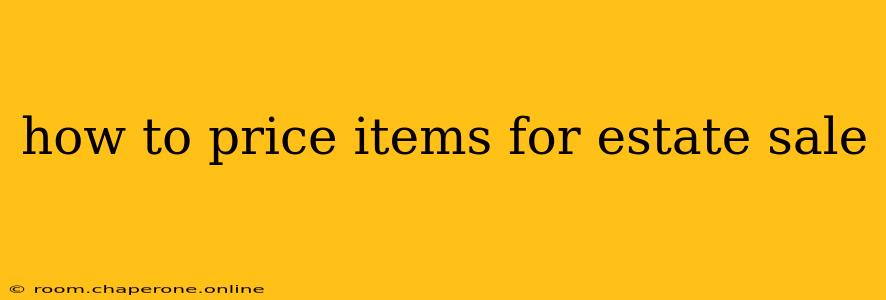Successfully pricing items for an estate sale requires a delicate balance: you need to attract buyers with competitive prices while maximizing profit for the estate. This isn't just about slapping numbers on items; it's about understanding market value, appealing to specific buyer segments, and employing effective pricing strategies. This guide will walk you through the process, from initial research to final sale day.
1. Research and Appraisal: Laying the Foundation
Before you even think about price tags, thorough research is crucial. This phase sets the stage for successful pricing and avoids costly mistakes.
1.1 Understanding the Market:
- Online Marketplaces: Explore eBay, Etsy, Facebook Marketplace, and specialized antique/collectible sites to see what similar items are selling for. Pay close attention to "sold" listings, not just active ones. Location matters; regional demand can significantly impact pricing.
- Local Auction Houses: Check recent auction results from reputable houses in your area. This gives you a realistic benchmark for valuable items.
- Antique Shows and Flea Markets: Visiting these events provides firsthand insights into current market trends and pricing. You'll see what's popular, what's not, and how similar items are priced.
- Specialized Appraisers: For high-value items like jewelry, art, or collectibles, consider consulting a professional appraiser. Their expertise ensures accurate valuation and can prevent undervaluing significant assets.
1.2 Item-Specific Evaluation:
- Condition: The condition of an item drastically affects its value. Note any damage, wear, or imperfections. Excellent condition commands higher prices than damaged or worn items.
- Rarity and Authenticity: Research the item's history, maker, and materials. Rare or authentic items often fetch premium prices. Verify authenticity whenever possible.
- Completeness: Is the item complete with all its original parts or accessories? Incomplete items are usually worth less.
- Demand: Consider current trends and the overall demand for the specific item. Seasonal items might have fluctuating values.
2. Pricing Strategies: Balancing Profit and Sales
Once you've researched market values, it's time to develop a pricing strategy. Several approaches can be effective:
2.1 The Competitive Pricing Approach:
This involves pricing items similarly to what you've observed on online marketplaces and at local auctions. It's a safe bet, ensuring your items are competitively priced and likely to sell.
2.2 The Value-Based Pricing Approach:
This approach focuses on the item's inherent value, considering its rarity, condition, and historical significance. It's ideal for high-value items where you want to maximize profit.
2.3 Tiered Pricing:
Consider offering different price points based on the item's condition or desirability. This allows for flexibility and caters to different buyer budgets.
2.4 Bundling:
Group related items together and offer them at a discounted price. This can encourage impulse buys and clear out multiple items at once.
3. Setting Prices: Practical Tips
- Start High, but Be Realistic: It's better to start with slightly higher prices and gradually reduce them as the sale progresses, than to undervalue items from the start.
- Use Clear and Visible Price Tags: Make sure each item is clearly marked with its price. Use easily readable tags and consider color-coding for different price categories.
- Consider Discounts: Offer discounts for bulk purchases or on the final day of the sale to encourage last-minute sales.
- Negotiation: Be prepared to negotiate prices, especially on higher-value items. A little flexibility can close the deal.
4. Beyond Pricing: Enhancing Your Estate Sale Success
- Staging and Presentation: A well-organized and attractively presented sale will attract more buyers and justify higher prices.
- Marketing and Advertising: Promote your estate sale through various channels (online listings, flyers, local newspapers) to reach a wider audience.
- Professional Help: If you're overwhelmed, consider hiring a professional estate sale company. They handle all aspects, from pricing and marketing to the sale itself.
Pricing items for an estate sale is a multifaceted process. By combining thorough research, strategic pricing, and effective presentation, you can maximize the sale's success, ensuring a fair return for the estate. Remember, patience and adaptability are key to navigating the complexities of estate sale pricing.

